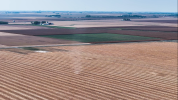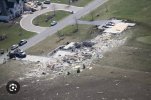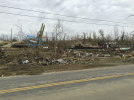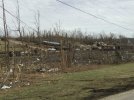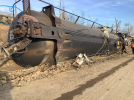Also Chickasha-Blanchard.Rochelle should be an EF5 as well. I was going to say that we don't need to go back to the era where EF5 ratings were still a thing but I think Goldsby merits a second look.
Navigation
Install the app
How to install the app on iOS
Follow along with the video below to see how to install our site as a web app on your home screen.
Note: This feature may not be available in some browsers.
More options
-
Welcome to TalkWeather! We see you lurking around TalkWeather! Take the extra step and join us today to view attachments, see less ads and maybe even join the discussion. CLICK TO JOIN TALKWEATHER
You are using an out of date browser. It may not display this or other websites correctly.
You should upgrade or use an alternative browser.
You should upgrade or use an alternative browser.
Just to add to the obvious that we know. Why not add Vilonia in there too.Also Chickasha-Blanchard.
AJS
Member
Oh absolutely. Probably the most egregious candidate of them all.Just to add to the obvious that we know. Why not add Vilonia in there too.
tornado examiner
Member
Especially lawn grass. Which is highly resilient to tornadic winds.I don’t want to derail (hah!) the conversation too much, but while on the topic of contextual damage, I don’t think I’ve found a better picture illustrating
why grass scouring is a much better violent tornado indicator than farm field “scouring”.
View attachment 46953
AJS
Member
Just to add to the obvious that we know. Why not add Vilonia in there too.
Oh absolutely. Probably the most egregious candidate of them all.
Even house construction aside: 15 tons, 3/4 of a mile. I’m not a mathematician by any stretch of the imagination, but that seems like another candidate for calculation-based EF5.
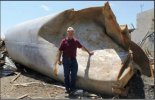
Shakespeare 2016
Member
There are a number of tornadoes from this year that could be upgraded to at least an EF4.To be totally honest...I wasn't sure I'd ever see the day. The drought started a few months before I got into watching severe weather, and I'd started to have a feeling that the EF5 rating was just not going to be used anymore.
Let's be real, there are at least half a dozen EF4s over the last 12 years which should be upgraded, and the number of EF3s that should to be bumped up to EF4 is probably in the double digits.
CheeselandSkies
Member
And, as a nice addendum: my entire weather career so far has been spent with the dream of one day tracking an EF5 in situ. Today, I learned that my dream has finally come true.
Here's how long it's been: When Moore happened I was still a student at Milwaukee Area Technical College and was had class that afternoon (I'd actually finished the core courses in my degree program a year prior, but hung around taking a few more classes mainly so I could continue working part-time as a student employee at the Milwaukee PBS TV station, which is located on campus).
I knew there was a risk of severe storms and tornadoes in central Oklahoma that day, so I surreptitiously pulled up one of the Oklahoma City TV stations' websites on the classroom computer I was using, and opened up the live stream to see the whirling black wedge hurling debris everywhere, and knew I was witnessing history just like the day two springs prior (toward the end of my first year in that same degree program) when I got home from class and pulled up GR Level 3 just in time to see the debris ball over Tuscaloosa.
Last edited:
joshoctober16
Member
Tornadoes to note , note the new rules state (a large heavy compact (full) object being thrown at 50+ meters)Tornadoes that could potentially be upgraded due to this brand new precedent:
Matador, TX 2023 (New: EF-5)
Little Rock, AR 2023 (New: EF-4)
Andover, KS 2022 (New: EF-4)
Mayfield, KY 2021 (New: EF-5)
Tri State AR-MO-TN 2021 (New: EF-5)
Bassfield-Soso MS 2020 (New: EF-5)
Chapman, KS 2019 (New: EF-5)
Vlionia, AR 2014 (New: EF-5)
Tuscaloosa, AL 2011 (New: EF-5)
New Wren, MS 2011 (New: EF-5)
The list goes on, the surface is barely touched of upgradable tornadoes.
Mayfeild 2021: threw a train car up a hill by 40 meters and it was much much more heavier then what most train cars are at.
Vilonia 2014: threw some heavy large tankers at almost a mile away.
tuscaloosa 2011: did the same thrown train car distance as Enderlin tornado , however unsure if its full , if it was full and not empty then there is 0 reason to not rate it under EF5 anymore.
new wren 2011: threw a truck 1.7 miles away.
Stanton 2014: threw cars a mile away , im hearing it might of thrown heavy objects 6+ miles away.
Cisco 2015: threw a car and other large objects over a mile away.
and of course there are the already rated EF5 tornadoes , like greensburg thrown oil tanks at over 7+ miles away! and moore throwing some more then a mile away.
these seems to be the main obvious ones they should relook at.
Ozonelayer
Member
How much did the Mayfield Train weigh? I'm going to calculate it but I need the weight.Tornadoes to note , note the new rules state (a large heavy compact (full) object being thrown at 50+ meters)
Mayfeild 2021: threw a train car up a hill by 40 meters and it was much much more heavier then what most train cars are at.
Vilonia 2014: threw some heavy large tankers at almost a mile away.
tuscaloosa 2011: did the same thrown train car distance as Enderlin tornado , however unsure if its full , if it was full and not empty then there is 0 reason to not rate it under EF5 anymore.
new wren 2011: threw a truck 1.7 miles away.
Stanton 2014: threw cars a mile away , im hearing it might of thrown heavy objects 6+ miles away.
Cisco 2015: threw a car and other large objects over a mile away.
and of course there are the already rated EF5 tornadoes , like greensburg thrown oil tanks at over 7+ miles away! and moore throwing some more then a mile away.
these seems to be the main obvious ones they should relook at.
The study includes vehicles in the list of 50 meter EF5 indicators. It's not just restricted to abnormally heavy objects. The tanker from Enderlin was four times heaver and thrown two times further than any item they studied. They found even hay bails require 200 mph+ winds to throw 50 meters and those aren't ridiculously heavy by any stretch. It's honestly crazy. The study blows tornado ratings WIDE open. I really want to see their work expanded on with all sorts of other objects. I can't imagine the winds required to throw a 15 ton barrel 3/4ths of a mile, but the tools are there now to figure it out (for people who can comprehend the math lol).Tornadoes to note , note the new rules state (a large heavy compact (full) object being thrown at 50+ meters)
Mayfeild 2021: threw a train car up a hill by 40 meters and it was much much more heavier then what most train cars are at.
Vilonia 2014: threw some heavy large tankers at almost a mile away.
tuscaloosa 2011: did the same thrown train car distance as Enderlin tornado , however unsure if its full , if it was full and not empty then there is 0 reason to not rate it under EF5 anymore.
new wren 2011: threw a truck 1.7 miles away.
Stanton 2014: threw cars a mile away , im hearing it might of thrown heavy objects 6+ miles away.
Cisco 2015: threw a car and other large objects over a mile away.
and of course there are the already rated EF5 tornadoes , like greensburg thrown oil tanks at over 7+ miles away! and moore throwing some more then a mile away.
these seems to be the main obvious ones they should relook at.
Seriously, even the largest hay bails are way less than 2000 pounds.
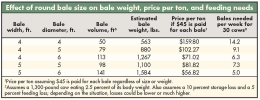
joshoctober16
Member
also i think there are 1 or 2 tornadoes that they should rate as EF5 , with one being 100%
reason why the enderlin ef5 rating used the logic from one of the papers posted as a link in here https://uwo.ca/ntp/blog/2025/csslntp_research_assists_with_rating_historic_ef5_tornado_in_us.html
you will find
here is that paper
and here is the results of 2 of the tornadoes
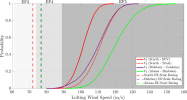
the alonsa EF4 tornado has a 100% chance of having 201+ mph winds using the same logic.
therefor alonsa is the first of the (potentially be upgraded due to this brand new precedent) that should be upgraded.
thus alonsa and enderlin should be rated the same rating , if enderlin is a EF5 so is alonsa
if alonsa is just a EF4 and not a EF5 then enderlin is just a EF4 and not a EF5.
reason why the enderlin ef5 rating used the logic from one of the papers posted as a link in here https://uwo.ca/ntp/blog/2025/csslntp_research_assists_with_rating_historic_ef5_tornado_in_us.html
you will find

here is that paper
and here is the results of 2 of the tornadoes

the alonsa EF4 tornado has a 100% chance of having 201+ mph winds using the same logic.
therefor alonsa is the first of the (potentially be upgraded due to this brand new precedent) that should be upgraded.
thus alonsa and enderlin should be rated the same rating , if enderlin is a EF5 so is alonsa
if alonsa is just a EF4 and not a EF5 then enderlin is just a EF4 and not a EF5.
Shakespeare 2016
Member
There is no secret what high-end vehicle damage looks like.Still a fairly lazily put together DI proposal IMO. Why are they artificially limiting it to EF3 max when we know what EF4-5 vehicle damage looks like? Hopefully they change it before final rollout.
This may blow the lid off of the current set of wind speed estimates. I think we’re all starting to realize that Fujita had it right the first time around, and I hope the experts can put their pride aside and reach the same conclusion.The study includes vehicles in the list of 50 meter EF5 indicators. It's not just restricted to abnormally heavy objects. The tanker from Enderlin was four times heaver and thrown two times further than any item they studied. They found even hay bails require 200 mph+ winds to throw 50 meters and those aren't ridiculously heavy by any stretch. It's honestly crazy. The study blows tornado ratings WIDE open. I really want to see their work expanded on with all sorts of other objects. I can't imagine the winds required to throw a 15 ton barrel 3/4ths of a mile, but the tools are there now to figure it out (for people who can comprehend the math lol).
Seriously, even the largest hay bails are way less than 2000 pounds.
View attachment 46959
- Messages
- 4,553
- Reaction score
- 9,245
- Location
- California, United States
- Special Affiliations
- SKYWARN® Volunteer
This thread for most of last month:

This thread after Enderlin's upgrade:


This thread after Enderlin's upgrade:

Shakespeare 2016
Member
I have been saying that for years. No most of us are not engineers but violent high-end contextual damage tends to be very obvious to people who know about rating damage.This may blow the lid off of the current set of wind speed estimates. I think we’re all starting to realize that Fujita had it right the first time around, and I hope the experts can put their pride aside and reach the same conclusion.
AJS
Member
For those who watched WWE:
Michael Cole when the undertakers streak ended and us today for Enderlin: “ The streak… is over. “
Michael Cole when the undertakers streak ended and us today for Enderlin: “ The streak… is over. “

